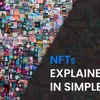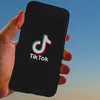NFTs and monetising your creations explained at Techsparks 2021
To explain NFTs and how they help artists monetise their creations, Raj Shamani, Founder, Shamani Industries, and Digital Content Creator and Investor, and Sai Krishna VK, Founder, Scapic, hosted a masterclass at YourStory's TechSparks 2021. Here's all you need to know:
NFTs or Non-Fungible Tokens have taken the media by storm in recent months.
The sale of an NFT by digital artist Beeple (Mike Winkelmann) for $69 million earlier this year opened the floodgates for scores of other NFT sales by various artists, musicians, actors, and regular users.
In fact, some of these digital assets — in the form of images, videos, etc., — are traded for hundreds, thousands, and even millions of dollars. NFTs are also finding applications across segments, including gaming, digital identity apps, licensing and certification, digital art, etc.
To explain NFTs and how they help artists monetise their creations, Raj Shamani, Founder, , and Digital Content Creator and Investor, and Sai Krishna VK, Founder, , hosted a masterclass at YourStory's TechSparks 2021.
Raj Shamani explained:
"In simple terms, an NFT can help me be the sole owner of something I really want to own. Back when I was a kid, I used to have a few favourite action cards of pro wrestlers, but other kids on the block also had the same ones. If such cards were digital, and if they were NFTs, there would be just one digital version of each card or collectable, and I would be their sole owner."
Sai Krishna VK explained that NFTs now allow us to look at "points or moments in history or Internet culture" and make them monetisable," referencing Twitter Founder Jack Dorsey's first-ever tweet that sold as an NFT for $2.9 million.

Non-fungibility explained
The duo also discussed what 'non-fungibility' means and explained how NFTs are not interchangeable.
Fungibility refers to an asset’s interchangeability. Fiat currencies, such as dollars or rupees, are tangible as a hundred-rupee note is interchangeable with another hundred-rupee note.
Fungibility is an essential characteristic of fiat currencies since they serve as a medium of exchange. Even cryptocurrencies are considered fungible as one Bitcoin owned by individual A is always equal in value to one Bitcoin owned by person B.
But NFTs are unique and do not serve as a medium of exchange. Rather, they are collectables and serve as proof of ownership of a certain digital asset. Thus, they are non-fungible, i.e., they are not exchangeable with one another.
"NFTs can become the default mode of commerce in an Internet-first world. Anything that trades hands can be potentially be traded as an NFT in the online world," Sai Krishna added.
New entrants to the space often wonder how ownership of NFTs works and how it can be proven. The answer lies in the recorded proof of ownership. Blockchains like Ethereum or Binance Smart Chain are used to document proof of ownership of NFTs.
Raj Shamani and Sai Krishna went on to reveal how the technology behind NFTs allows proof of ownership to be recorded on these blockchains.
The proof of ownership is traceable on blockchains as they are public distributed ledgers. Raj Shamani added, "On a blockchain, nodes [or users] can recognise the proof of ownership provided by the NFT's smart contract that self-executes when an NFT is transferred."
"The smart contracts also enable owners to unlock special things such as the opportunity to meet a celebrity or get access to specific things only available to the owner of the NFT," added Sai Krishna.
The duo also dived into how NFTs can be created, bought, and sold.
Raj Shamani explained, "Users can buy cryptocurrency like Ethereum through an exchange and send it to their wallets, such as MetaMask. They can go to NFT marketplaces such as OpenSea or Rarible and begin searching, buying, and creating NFTs on it."
Sai Krishna said, "The ability to create and upload an NFT on OpenSea is easy. First, you should have an original piece of art. Then on OpenSea, you can select which blockchain you want to upload your NFT to, such as Ethereum, Polygon, etc. Then you add details about your NFT, add custom rewards if any, and then hit 'mint', which means create. Your NFT is now live."

Why do NFTs have value?
The characteristics of NFTs allow users to program digital scarcity into these virtual assets — a factor crucial to giving NFTs their value.
Just like most valuable items (gold, currency, crypto), value isn’t inherent to NFTs. In financial systems, value is a shared belief or consensus.
In other words, something has value if people believe it does and are willing to buy/sell or trade that item.
Raj Shamani explained, "In an NFT marketplace, there are buyers and sellers, just like any regular marketplace. Buyers pay what they feel an NFT is worth. Buyers may also feel NFTs are more than just collectables - perhaps they can act as an entry point or membership to an exclusive community or club of like-minded individuals."
He added that he personally looks at the value of an NFT by considering the size of the community built around such digital assets, the community members, and the recommendations of those he trusts.
Sai Krishna echoed Raj Shamani's sentiment and added, "NFTs right now have three levers: art, scarcity, and community. There is a historical value associated with existing digital art, but it can be copied. So you build digital scarcity by engineering a smart contract and creating an NFT. So this creates a market for people who want to own it and have similar interests, which is the community."
To log in to our virtual events platform and experience TechSparks 2021 with thousands of other startup-tech enthusiasts from around the world, join here. Don't forget to tag #TechSparks2021 when you share your experience, learnings and favourite moments from TechSparks 2021.
For a line-up of all the action-packed sessions at YourStory's flagship startup-tech conference, check out TechSparks 2021 website.

Edited by Suman Singh









